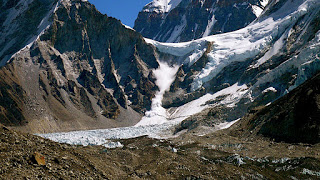One of the major milestones each year on Everest is the completion of the route through the Khumbu Icefall. For those who aren’t aware of what I’m referring to, there is a section of glacier just above Base Camp that the climbers must move through each time they head up to Camp 1 or higher. The problem is that the glacier is moving and the giant blocks of ice shift and change constantly. That makes for a very unsteady surface made all the more challenging by the large crevasses that spider-web across the area.
In order to cross this very dangerous section (more people have died in the icefall than on the route to the summit!) a special team of Sherpas known as the Ice Doctors must locate and construct a safe passage every year. To do so, they set down a series of ladders that span the distance across the crevasses and when passing through the icefall, the climbers walk across those ladders in order to get from one area to the next. It can be an extremely unnerving process for the climbers, who generally pass through the Khumbu four or five times in a season.
Today the IMG team reported that the Ice Doctors have completed their work and the route through the Khumbu Icefall is now open. That means that when most teams arrive at Base Camp, then can get settled for a day or two and immediately begin the climb to Camp 1. In fact, the IMG dispatch says that their Sherpas have already crossed through the icefall and raced up to C1 and 2 to claim their campsites. This is extremely early in the season to have that route finished, let along have anyone as high as Camp 2. That bodes well for those looking to get an early start on the acclimatization process.
While trekking up the valley to Base Camp a two years ago I saw a number of sections of the ice simply collapse. Throughout the hike to BC there was constant cracking and rumbling from the glacier that was a bit unsettling even hiking alongside of it. Over the next two months, the Ice Doctors will continue to maintain their route through the icefall an ensuring that it is safe for climbers, but they know that on any given day they could discover a section that was stable the day before is completely gone the following day. It is a tough job and vitally important to every climber who hopes to go to the summit.
Yesterday I posted a story reminding everyone that Everest isn’t the only mountain that will see action this spring. That aside, there are still some impressive plans for the Big Hill has as well. For instance, Bill Burke is hoping to achieve a double-summit, climbing the mountain from both the North and South Sides. Oh, and did I mention that he is 70 years old?
Chad Kellogg is back on the mountain this year as well and looking for a speed record. Alan Arnette points out today that Chad is hoping to best the record set by Marc Batard back in 1988 which would mean 22.5 hours to the summit and 30 hours roundtrip starting at BC. (Update: There does seem to be a dispute over what is the official “speed record” for Everest. We’ll have to watch and see how things unfold as the season goes on.)
Also, it should be pointed out that Phil Henderson, who is leading the Nat Geo team on the Southeast Ridge, is hoping to become the first African American man to summit the world’s tallest peak. He shares his thought on the climb, and a lot more, in this interview.
Indian climber Loveraj Dharmashaktu is hoping to become the first person from that country to summit Everest without supplemental oxygen, while Russian Alex Abramov hopes to open a new route on the North Side of Everest.
So there you have it. Plenty going on throughout the Himalaya and especially on Everest.
- Gear Review: The Xero Scrambler Mid is an Ultralight Hiking Shoe for Spring - March 1, 2023
- Gear Review: Yeti Roadie 48 Wheeled Cooler - August 18, 2022
- Kristin Harila Continues Pursuit of 8000-Meter Speed Record - August 16, 2022
